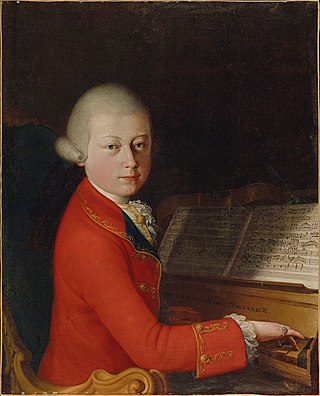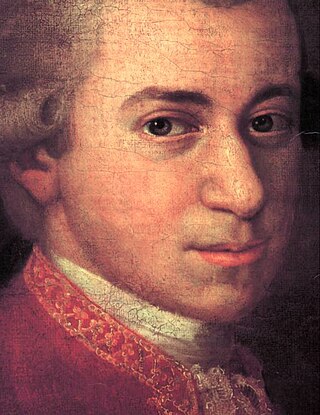
The Piano Sonata No. 11 in A major, K. 331 / 300i, by Wolfgang Amadeus Mozart is a piano sonata in three movements.

The Bassoon Concerto in B-flat major, K. 191/186e, is a bassoon concerto written in 1774 by Wolfgang Amadeus Mozart. It is the most often performed and studied piece in the entire bassoon repertory. Nearly all professional bassoonists will perform the piece at some stage in their career, and it is probably the most commonly requested piece in orchestral auditions – it is usually requested that the player perform excerpts from the concerto's first two movements in every audition.
Violin Concerto No. 2 in D major, K. 211 was composed by Wolfgang Amadeus Mozart in 1775. The concerto has the usual fast–slow–fast structure. The movements of the work have the tempo headings:

The Piano Sonata No. 13 in B-flat major, K. 333 (315c), also known as the "Linz Sonata", was composed by Wolfgang Amadeus Mozart in Linz at the end of 1783.

The Kegelstatt Trio, K. 498, is a piano trio for clarinet, viola and piano in E-flat major by Wolfgang Amadeus Mozart.
Violin Concerto No. 4 in D major, K. 218, was composed by Wolfgang Amadeus Mozart in 1775 in Salzburg. The autograph of the score is preserved in the Biblioteka Jagiellońska, Kraków. He seemed to have originally composed it for himself to play, but after leaving the Salzburg Court Orchestra, he changed and updated the concerto for the successor of his position in his orchestra, Antonio Brunetti, to play. It is debatable whether the concerto was above Mozart's level of mastery or if he purposely made the concerto difficult for Brunetti on account of his greater ability. The first movement is nicknamed the “military” Mozart Concerto while the second movement consists of melodic lines. The third movement is joyful and full of fun.

Wolfgang Amadeus Mozart's Piano Sonata No. 8 in A minor, K. 310 / 300d, was written in 1778. The sonata is the first of only two Mozart piano sonatas in a minor key. It was composed in the summer of 1778 around the time of his mother's death, one of the most tragic times of his life.

Wolfgang Amadeus Mozart began his series of preserved piano concertos with four that he wrote in Salzburg at the age of 11 : K. 37 and 39–41. The autographs, all held by the Jagiellonian Library, Kraków, are dated by his father as having been completed in April and July of 1767. Although these works were long considered to be original, they are now known to be pasticcios of sonatas by various German composers. The works on which the concertos are based were largely published in Paris, and presumably Mozart and his family became acquainted with them or their composers during their visit to Paris in 1763–64.

The Serenade No. 10 for winds in B-flat major, K. 361/370a, is a serenade by Wolfgang Amadeus Mozart scored for thirteen instruments: twelve winds and string bass. The piece was probably composed in 1781 or 1782 and is often known by the subtitle Gran Partita, though the title is a misspelling and not in Mozart's hand. It consists of seven movements.

The Sonata for Two Pianos in D major, K. 448 (375a), is a work composed by Wolfgang Amadeus Mozart in 1781, when he was 25. It is written in sonata-allegro form, with three movements. The sonata was composed for a performance he would give with fellow pianist Josepha Auernhammer. Mozart composed this in the galant style, with interlocking melodies and simultaneous cadences. This is one of his few compositions written for two pianos.

Wolfgang Amadeus Mozart's Piano Sonata No. 9 in D major, K. 311 / 284c, was written on the composer's stay in Augsburg and Mannheim in November-December 1777, and is contemporaneous with his Sonata No. 7 in C Major K. 309. The three sonatas K. 309–311 were published as a set 'Opus IV' in about 1782, by Franz Joseph Heina in Paris.

The Piano Concerto No. 6 in B-flat major, K. 238, was composed by Wolfgang Amadeus Mozart in January 1776. His Concerto No. 7 for three pianos and his Concerto No. 8 in C major would follow within three months. The three works share what Cuthbert Girdlestone refers to as a galant style.

Wolfgang Amadeus Mozart's Piano Sonata No. 10 in C major, K. 330 / 300h, is one of the three works in the cycle of piano sonatas K.330-331-332. The sonata was composed in 1783, when Mozart was 27 years old. It was published, with the other two sonatas by Artaria in 1784. A typical performance of this sonata lasts around twenty minutes.

Wolfgang Amadeus Mozart's Piano Sonata No. 1 in C major, K. 279 / 189d (1774), is a piano sonata in three movements. Except for the first part of the opening movement, it was written during the visit Mozart paid to Munich for the production of La finta giardiniera from December 1774 to March 1775. Although Mozart is known to have written at least five other solo piano sonatas in his youth, K.279 is the first of his 18 extant solo piano sonatas. A typical performance of the sonata takes about 14 minutes.

Wolfgang Amadeus Mozart's Piano Sonata No. 5 in G major, K. 283 / 189h, (1774) is a piano sonata in three movements:
The six string quartets, K. 168–173, were composed by Wolfgang Amadeus Mozart in late 1773 in Vienna. These are popularly known as the Viennese Quartets. Mozart may have hoped to have them published at the time, but they were published only posthumously by Johann André in 1801 as Mozart's Op. 94.
Violin Sonata No. 32 in B-flat major is a composition by Wolfgang Amadeus Mozart. It was completed in Vienna on April 21, 1784, and was published by Christoph Torricella in a group of three sonatas.
The Sonata in F for Violin and Keyboard, K. 547, was completed in Vienna on July 10, 1788 by Wolfgang Amadeus Mozart. The sonata is often nicknamed "For Beginners" and was completed two weeks after the similarly nicknamed piano sonata in C major, K. 545. Unlike the previous few keyboard sonatas, where the violin played an equal role, this sonata is dominated by the keyboard part. In that regard, only the violin part is easy and the keyboard part is not "for beginners".
The divertimenti in F major, B-flat major, E-flat major, F major, and B-flat major are five companion compositions for pairs of oboes, horns and bassoons by Wolfgang Amadeus Mozart.









